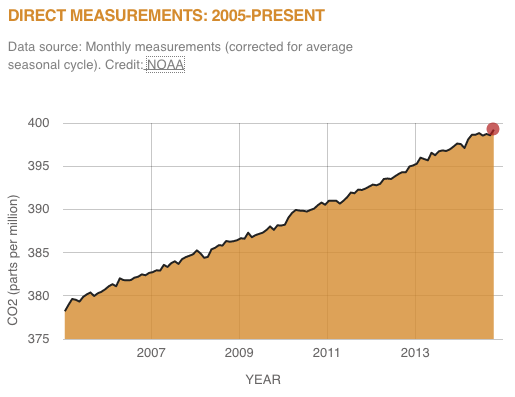Declining Air Quality
Declining Air Quality
Today, the link between air pollution and climate change is widely accepted. According to the Environmental Protection Agency (EPA), human activities have generated air pollution since the Industrial Revolution began in the mid-18th century. Carbon dioxide (CO2) and other heat-trapping gases are considered the primary culprits; electric power, automotive transportation and industrial processes have historically emitted vast quantities of gas particles that remain in the atmosphere. In addition to capturing heat and causing temperatures to rise, carbon emissions generate a significant amount of air pollution.
Carbon Dioxide Concentration Levels

Image via NASA. The National Oceanic and Atmospheric Administration (NOAA) monitors CO2 levels from their earth systems lab in Manua Loa, HI where concentration levels have increased steadily for over a decade.
Many effects of air pollution are invisible, but smog ― hazy clouds of stagnant air and ozone gas particles that hover above metropolitan centers ― can be seen with the naked eye throughout the year over heavily polluted cities like Los Angeles and Beijing. The EPA notes that as of 2008 more than 126 million Americans resided in U.S. counties that did not meet air quality standards put in place by the federal government.
A phenomenon known as ‘ground-level ozone’ occurs when carbon monoxide and other toxic gases mingle with one another while being exposed to sunlight. The EPA links ground-level ozone conditions to diminished lung function and inflammation of the airways. Studies have also suggested that a higher number of people have been diagnosed with asthma due to exposure to ground-level ozone.
In addition, ‘particulate matter’ is a term for tiny droplets of gas and moisture that are generated by a number of sources (including diesel and gasoline engines, wood combustion and industrial processing) and that linger in the atmosphere.
According to the EPA, inhalation of particulate matter “can lead to a broad range of adverse health effects, including premature mortality, aggravation of cardiovascular and respiratory disease, development of chronic lung disease, exacerbation of asthma and decreased lung function growth in children.”
Children, the elderly, outdoor workers and asthmatic people are all considered vulnerable to lung problems in areas with ground-level ozone. A 2014 report from the World Health Organization suggests that as many as 7 million people died in 2012 as a result of exposure to air pollution; this figure represents one in eight global deaths. Of outdoor air pollution related deaths, roughly 80% were attributed to two diseases: ischaemic heart disease and stroke:
- Ischaemic heart disease: 40%
- Stroke: 40%
- Chronic obstructive pulmonary disease (COPD): 11%
- Lung cancer: 6%
- Acute lower respiratory infections in children: 3%
In light of these findings, the WHO has declared air pollution as “the world’s largest single environmental health risk” and that “reducing air pollution could save millions of lives.”
